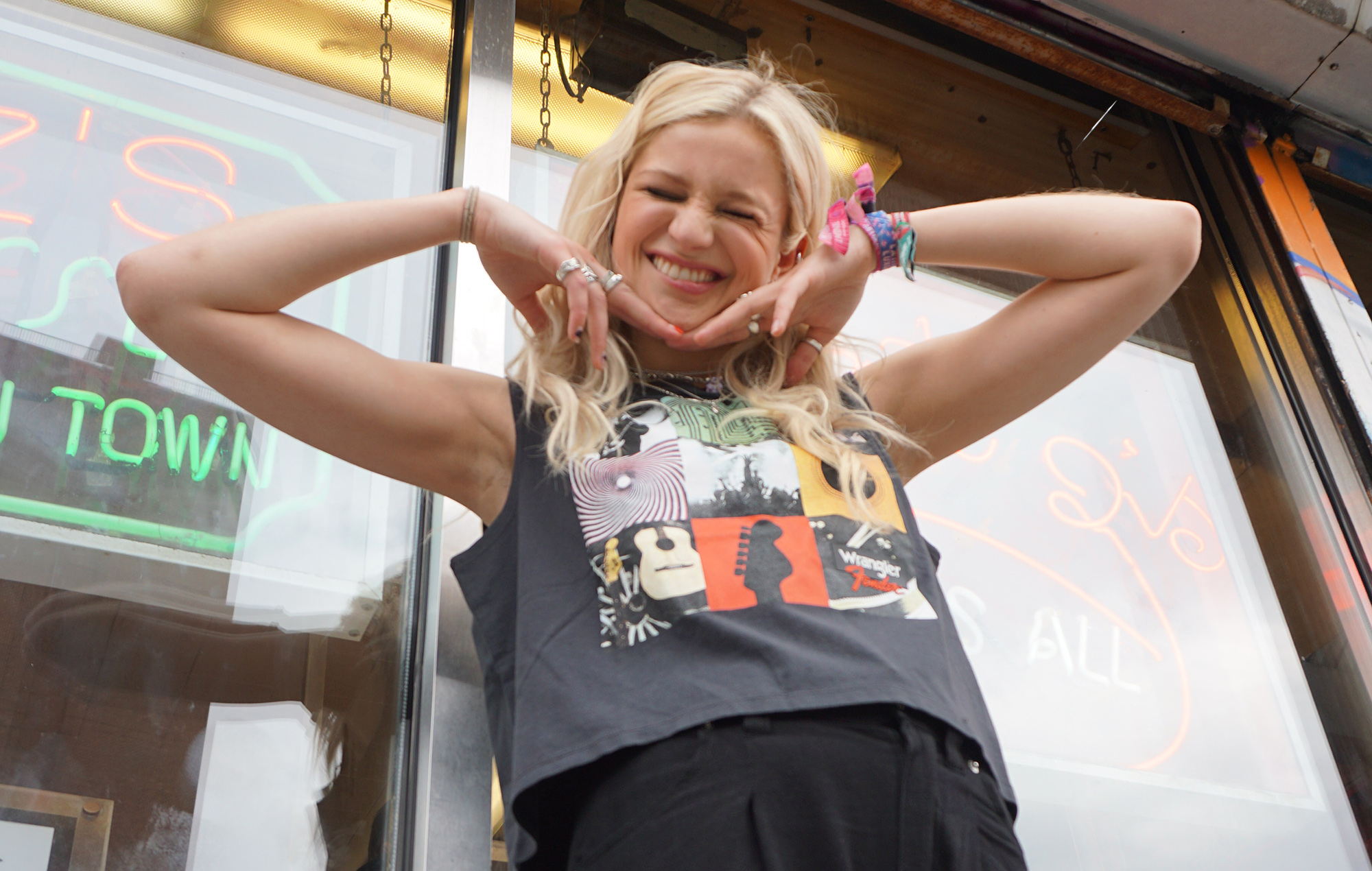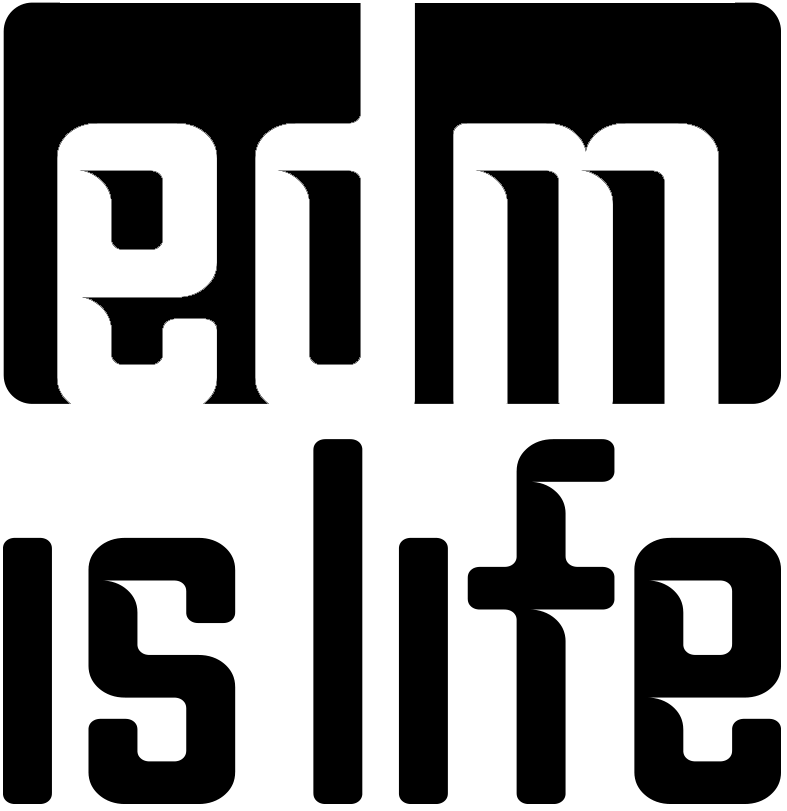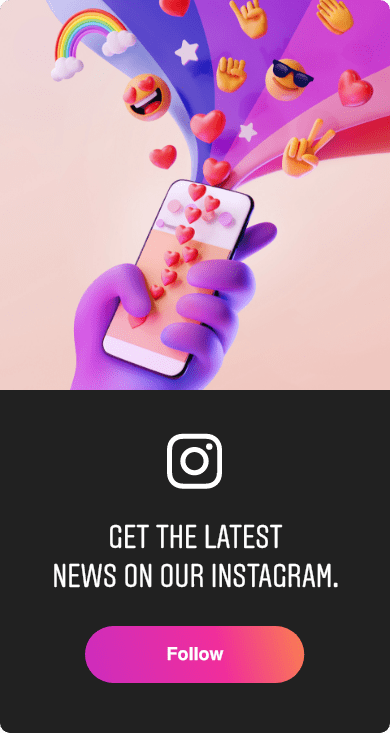
Bright lights and the big city: future pop hero Dylan takes New York
An image of genuine triumph looms from Dylan’s phone screen. When the pop-rock vocalist – born Natasha Woods – notices NME looking over at it, she picks the device up and hovers it towards us, while a wide, proud smile begins to spread across her face. The 22-year-old’s lockscreen wallpaper is a photo of her performing on stage at London’s Wembley Stadium: electric guitar attached to her side, head thrown back, revelling in the euphoric rush of the moment.
Throughout the first few weeks of summer, Dylan opened up for Ed Sheeran across his UK-wide stadium tour, which culminated in five sold-out nights at Wembley. The support slot was “a genuine dream come true” for Dylan, as she played her big-chorused guitar anthems – in which she blends 100mph riffs with woozy and restless production, making for a portrait of an artist keen to emphasise her range – to the biggest crowds of her career thus far. “When I was younger, one of my goals was to play at Wembley,” she says. “But now I’ve had to shift the goalposts a little, and focus on eventually headlining [the stadium] instead.”
It’s a measure of what Dylan’s life has been like in 2022 that she’s already having to rewrite her bucket list. Today, she’s ticked off another goal, as we meet in downtown New York, mere hours ahead of her debut US headline show at the Mercury Lounge – the same venue that launched the careers of seminal indie acts The Strokes and The Yeah Yeah Yeahs in the early 2000s.
- Read More: Dylan live in New York: pop of this calibre deserves to be heard in arenas
We zigzag through the cobblestone streets of the city’s Soho district, a bustling enclave of high-end boutiques, laden with the hot greasy scents of curbside markets selling hotdogs and powdery-sweet waffles, while crumpled confetti rolls in the gutters outside nightclubs. It’s Dylan’s first time in New York, and she indulges in main character moments by window shopping, pretending to hail a yellow cab, and eyeing up tastefully decorated apartments for her ideal future: “Can you even imagine the songs I’d write living here?”
That forward planning is briefly interrupted as we traipse up 12 flights of stairs to reach a bohemian-style studio – previously used by the legendary Patti Smith – where Dylan will film an acoustic session this afternoon. “Not to be melodramatic, but I take back everything I said about wanting a New York apartment,” says Dylan breathlessly, her platform boots accentuating the creakiness of the floorboards, the thick mid-summer heat streaming through the windows above. Her manager shouts up the hallway in response: “You’re allowed to be dramatic, you’re a proper pop star now!”
Dylan is in the Big Apple for a whirlwind press tour in support of her upcoming mixtape, ‘The Greatest Thing I’ll Never Learn’ (due October 28), an eight-track collection full of feeling and fervour, spearheaded by lead single ‘Girl Of Your Dreams’, which recalls ‘The Best Damn Thing’-era Avril Lavigne via an adrenaline-surging melody and reverberating, blown-out production. With typical Gen Z versatility, she balances this nostalgic, all-caps rock sound with nimble and effusive pop flourishes – and an otherworldly confidence that few stars have so early on in their career.
Right now, Dylan is moving at rocket-speed – she’s an artist coming into her own after years of doubt. Growing up in Suffolk, she spent her high school years striving for success by taking extracurricular vocal, guitar and piano lessons, but was left mired in creative confusion after releasing two early EPs of fairly hesitant, electronica-influenced pop, 2019’s ‘Purple’ and its follow-up, ‘Red’. Establishing the remarkably self-assured sound that we hear on the new mixtape, she says, has been an uphill battle: “Previously, I was going to lots of producers, and was trying so hard to be everyone else.”

Dylan describes how her appearance at Latitude Festival in July was a breakthrough moment: she stormed the mainstage with a setlist comprised entirely of new music, including tracks from February’s super-slick ‘No Romeo’ EP. It’s clear that the uproarious audience response she received at Latitude has stayed with her; as we chat, she raises her arm to show us that, weeks later, she’s still wearing her artist wristbands from the festival.
As showtime approaches, last-minute nerves hover in the air at the venue, mixed with hairspray and the smell of tequila. Dylan attempts to stamp out the jitters by recording a video of her messing around during soundcheck for TikTok, beckoning her bandmates to join in. Outside, meanwhile, fans snake around the street corner, bearing gifts – flowers, American candy, a ‘No Romeo’-embellished ring – for their favourite artist, hopping from foot to foot in expectation of a meet and greet. Notably, two young girls are wearing ‘I Love Making Boys Cry’ t-shirts – a playful joke they attribute to Dylan’s own candidness in her music. “Dylan speaks to the teenage girl experience in her songs,” 17-year-old Isabella tells NME. “She’s engaging and honest towards us [fans], as if she’s our friend.”
After the gig, this grounded nature is fully realised, as Dylan spends an hour, in the rain, posing for photos and signing subway tickets and dollar bills. As we leave the noise behind and head for the city’s Lower East Side, after 30 minutes of walking around, a voice suddenly calls out from behind us: “Dylan! Your show was great,” a stranger shouts. “Keep up the good work!” Dylan is overcome with a mixture of shock and gratitude. “You asked me earlier if I’ve had my ‘I’ve made it’ moment yet,” she says to NME. “Well, it just happened right then.”
Eagle-eyed fans would have spotted a poster of New York City in the music video for ‘Girl Of Your Dreams’. What does it mean to you to be here?
“It’s surreal, because it doesn’t even feel like I’m here. My schedule has been jam-packed lately, so I haven’t quite had the time to process the fact that I’m on another continent, and I’m here to play my own music. It feels like I’m in another dimension at the moment. The reality of being an artist is hitting me now – I live and breathe to do this.”
Your performance at The Mercury Lounge will see you roadtest material from your forthcoming mixtape. When did these new songs begin to take shape?
“The whole process was really quick. The events described in some of the songs literally happened days before I hit the studio; it was like, ‘Let’s make a mountain out of a molehill and write about another chaotic experience’. But honestly, this mixtape is the soundtrack to my life, and that’s why I listen to music in the first place – to be the main character. It’s why I started listening to Taylor Swift when I was 15, as she makes music that represents the way I feel; she’s an amazing storyteller, and beyond that, the strongest woman in the world.
“But above all else, it’s genuinely amazing to have this piece of work that I love through and through. I listen to these songs every day, I am obsessed with [this mixtape]. Sometimes you’ve got to be your own biggest cheerleader, especially when you’ve worked so hard.”
“One of my goals was to play at Wembley, but I’ve had to shift the goalposts and focus on eventually headlining [the stadium]”
You’ve garnered a taste for performing at stadiums recently. How have you adapted your own live shows since?
“In terms of playing live, I’ve come on wonders this year, as I’ve been touring non-stop. I am now able to let loose, and focus on not worrying about what everyone else is thinking about my lanky dancing and knee slides. I don’t think that anyone else really embodies what I do, because it’s so hilariously awful – I don’t seem to have any control over my limbs when I play live, but that’s become part of my artist identity.”
While touring relentlessly over the past year, what routines have you had to put in place to avoid burnout?
“When I toured with Ed, I spoke to him twice about how fast things have changed for me, and how to deal with changing relationships back home. The first time we talked about how, when I was 19, I was having an awful time with friends as my career started to take off – only two people showed up to my birthday party. He said to me, ‘You’ve got to keep the people you have now really close to you, and not expect to make any new friends, as people [in music] are always going to want something from you.’
“A couple of months ago, I came off the road with Tate McRae and had a moment of feeling completely worthless. I think that it was massively to do with the post-tour comedown, which can be really intense if you’re on stage multiple nights a week. But since then, I have had some really good chats with mates about [touring], and have established that people are always going to walk in and out of my life. I’m now living in London, alone, but creating a much better routine to balance the extremes of my work.”

Have you been able to forge a new community for yourself in London? What other artists have you connected with since you moved to the capital?
“I’ve had a few dinners with a bunch of female artists, and just being able to sit and talk to them has been life-changing because you don’t have to explain all the [industry] terminology to them. You can just rant about your label and other pressures, and they get it – I think I’m slowly starting to get a gaggle of friends together, and it’s just been so refreshing.
“I’ve got to know Mae Muller, Rachel Chinouriri, and Griff, among others. Hanging out with and uplifting other female artists is so important: even if we’re not all in the same genre, we’re often played against each other, and that can be really stressful. We’ve also been able to share our experiences of blowing up on social media and cultivating an artist identity during the pandemic; for example, the first in-person [recording] session I did after COVID, I burst into tears from the pressure. It’s reassuring knowing that other people were going through the same thing that I was.”
Where do you draw the line of how much you’re willing to share of yourself online?
“When I first started out, I was totally against using social media because I didn’t want anyone to know anything about my life. Musically, I was having an identity crisis, but lockdown changed that for me – I started writing so much that I managed to snap out of that funk. I used to complain about the way my management would encourage me to use TikTok, but then my dad said to me, ‘How much do you want this? If you want to play Wembley one day, you’ve got to do everything you can to get there.’ That conversation switched my mindset entirely, and I now put myself out there online as I see it as a tool to help me connect with people.”
How did you overcome the “identity crisis” that informed the early days of your career?
“I’ll hold my hands up and say that, when I was 18, I thought I knew everything. I was trying to explore so many genres at once, and I think my drive came from an unhealthy place: a lot of it stemmed from revenge, as there were a lot of people that said I wouldn’t be able to make it as an artist, and music teachers who were difficult towards me. There were moments where I thought that I was genuinely not cut out [for making music]; I considered changing my artist name, I wanted to take down all of my old music… there were a lot of big decisions that I had to handle in a really short period of time.
“Eventually, there was just a moment where it all built up so much in my head that I needed to scream, and get it out in my music. I started going into sessions for the new music, and got everything out in my lyrics – and I would say that’s been better for me than actually going to a therapist.”

Do you see Dylan as a separate persona away from who you are as Natasha?
“I used to. But now, with this new music, the line has blurred: for me, there is now little difference between the two, which is a bit scary. But I think that being Dylan has given me the confidence to express myself in ways that I couldn’t before; I wanted to have a different name so that I could say things that I wouldn’t in real life. I also used to battle stage fright, but now, as Dylan, all I want to do is go on stage.
“I do, however, struggle to separate [Dylan and Tash] in my own life – it’s something I need to learn. That’s the next step: I want to be able to switch off. I am always in ‘promo mode’; even when I’m going out with friends, I feel like I’m on a press tour, and downtime for me is writing music. I’m very passionate about what I do, and I don’t think it’s necessarily a bad thing, but I’m learning to find a healthier balance.”
What other new challenges have you faced as your popularity has grown?
“I’ve had to learn resilience, and build new routines around an ever-changing sleep schedule and environment. There is so much responsibility that comes with being in this position; I have been getting messages on social media recently where people have said things like, ‘Your music is the reason I get out of bed in the morning’ or ‘Your music saved me’. Emotionally, it’s a lot to take on, but [the fans] make me feel like I’m doing something good – they’re giving me a purpose.”

What do you want your fans to take away from this new mixtape that they might not have known before?
“The mixtape is all about navigating friendships, relationships, and life in general, and I just hope that people will love these new songs as much as I do. I’m making sure that I look out for my fans, because after everything I’ve been through, they’ve accepted me and made me feel more confident in who I am as an artist. I just want us all to sing really loudly at [my] shows, and lose our voices together – I couldn’t ask for anything more, right?”
Dylan’s new single ‘Nothing Lasts Forever’ is out now via Island Records. Her debut mixtape ‘The Greatest Thing I’ll Never Learn’ will follow on October 28

![Music Remover from Video in 2025 [Top 6 Review]](https://edmislife.com/wp-content/uploads/2025/07/unnamed-29-png.webp)
